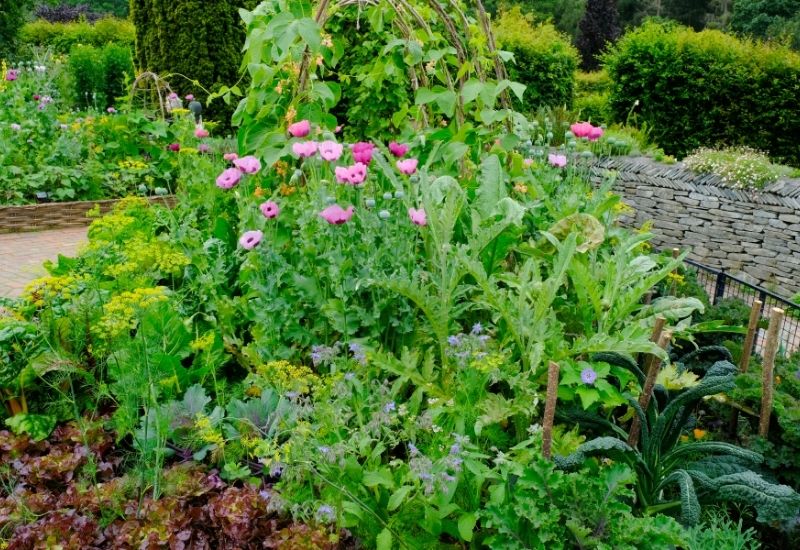
Each year, you spend hours starting vegetable seedlings indoors, tending to them, and planting them outside. You take even more time to care for the vegetables in your garden beds; it all takes a lot of time. You can decrease how much time you need to spend gardening by adding perennial vegetables that can be planted once and left to grow for many years.
It’s one way to expand your garden without adding more work to your back. Once you plant the perennials, all you have to do is plant them once, and then you tend to the plants for the next few years. Each year, you harvest vegetables, fruits, or herbs with little work.
So, if you’re new to edible perennial gardening, thinking of how to best spend your time finding the edible perennial crops you can grow. you’re come to the right place.
Stay with us to learn how to get the best from easy to grow perennial vegetables and seventeen of my favorite edible perennials and that you can grow in your garden and containers.
4 Reasons to Add Perennial Vegetables to Your Garden
So, why would you want to add perennial vegetables to your garden?
Annual vegetables are the majority of what we eat in our modern diet, but we forget about the perennials. Years ago, everyone added perennial veggies to their garden, but it seems to be lost over the years.
Here are some benefits of adding perennial crops to your garden beds
1. They Extend Your Garden Harvest
A majority of annual vegetables can be harvested throughout the summer, but perennials typically come to harvest in the spring. Some of them are the earliest harvestable veggies, making a fantastic start to your growing season.
2. Perennials Build UP Soil
When you plant your perennial plants, they’re there to stay, so make sure you pick a spot that will work for the long-term. You won’t till this area, so they keep the soil intact for the time being.
Since they have such deep roots, perennial plants pull up more trace minerals easier than other garden vegetables. That results in a healthier soil structure, creating an environment for worms, fungi, and beneficial bacteria.
As more time goes on, the plants add more organic matter to the soil as they lose their leaves. It builds the topsoil, encouraging the perennial plants to grow and thrive.
3. These Plants Require Little To No Maintenance
Perhaps the best reason to add perennial veggies is that they require little care from you once you plant them in your garden.
Perennial plants have deeper roots than annual so that they can withstand periods of drought or inconsistent watering. At the same time, perennials are more resistant to pests and diseases.
4. They Act As Decorations To The Landscape As Well
The last consideration is that perennial vegetables add more beauty to your garden beds. Some are quite large, and you can use them as edging plants or as a way to reduce erosion.
5 Tips for Growing Perennial Vegetable Garden
Growing perennial vegetables is a bit different than growing annual plants. You only plant them one time, so you want to get it right the first time. Here are some tips for growing these veggies in your edible perennial garden.
1. Research Your Plants’ Needs First
The first thing you need to do is research all of your plants and their needs. Perennial vegetables have particular needs, and you also need to know how long it takes for your plant to mature. Some perennials have a harvest during their first year, but others might not mature for five years.
That’s something you should know!
You also want to make sure the plant will grow well in your growing zone.
2. Consider Placement
Once you plant your perennials in their final spot, it’s not advised to move them. These plants take a lot of time to grow their deep root system, and the last thing you want to do is move them because you realized the placement isn’t perfect.
Look at where these perennial vegetables will grow the best. Some prefer full sunlight, but some prefer a partially shaded location or even a woodland site. If you want your veggies to thrive, you need to plant them in the best garden zone possible.
3. Amend The Soil First
You only plant them once, so you want to get it right. Put some extra time and effort into soil preparation, and your perennials will thank you. Perennials spend years, perhaps even decades, in the same spot, so now is the best time to amend the existing soil.
You can fix the existing soil by adding things such as:
4. Have Patience
One of the hardest parts of growing perennials is understanding and accepting that it takes several years to reach a mature size that will produce a harvest. It can be hard to have that type of patience when most gardeners are used to annual plants that produce in a few weeks or months.
5. Top-Dress And Fertilize Each Year
In the following years, your perennial plants still need nutrients and attention, but they don’t need as much as annual plants. Aside from the routine tasks, such as weeding, it’s recommended that you top-dress your plants with compost and use organic fertilizer in the spring to encourage healthy growth.
17 Edible Perennial Vegetables To Plant In Your Garden
You might not have heard of some of these vegetables, but they all deserve recognition as perennial veggies. These plants will continue to grow and provide you with nutrients without the extra work.
Plant these 17 edible perennial crops for an easy-care, long-lived and productive vegetable garden.
1. American Groundnut
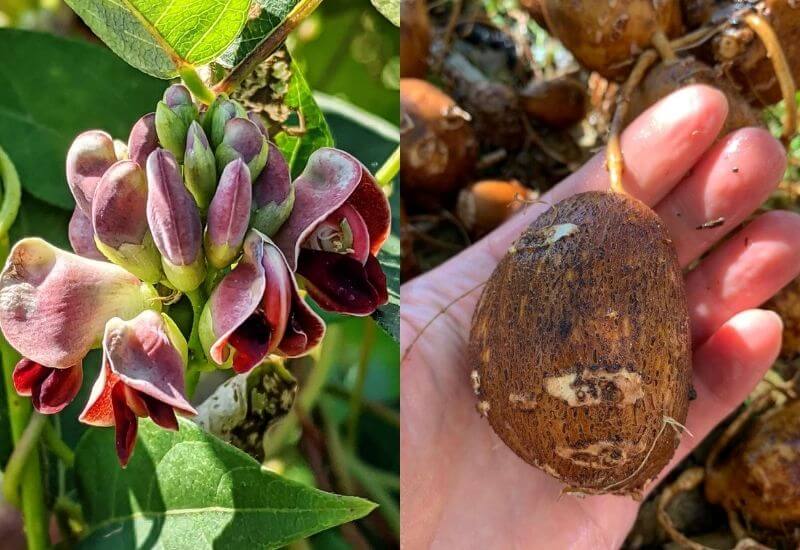
If you live in USDA zones 3-7, you can grow the American groundnut, a native vining plant that produces burgundy flowers.
You can eat several parts of the groundnut plant, including the beans, which need to be cooked. The young shoots are edible as well, but most prefer to enjoy the starchy tubers.
Despite being uncommon nowadays, American groundnuts are a great addition. They’re a vigorous plant that lives and thrives in moist soil. In nature, they like to grow in areas like a riverbank or near a stream.
The vines can reach up to ten feet long in a year, so you need to make sure you have a support structure for them.
They need an arch, an arbor, or a fence to grow up. As they grow, the tubers take up to three years to reach a mature size.
In the late fall, you’ll be able to harvest the tubers, but it’s best to wait until you’ve had a few hard touches of frost. Those will sweeten the tubers and make them even more delicious to eat.
When you harvest the American groundnuts, they look like a beaded necklace. Make sure you boil them beforehand, but then you can cook them however you want.
2. Asparagus

If you have more space in your garden, asparagus plants spread out over the years. The plants grow both wide and tall, and in the first few years, the plants slowly increase the spears that are sent up.
Asparagus is a hardy, long-living perennial plant that sends spears up in the mid to late spring.
Asparagus can be picky about where they grow. You need to make sure they have a sunny spot to grow with well-draining soil.
Remember, wherever you plant them, they have to stay; you won’t be able to move them in years to go.
When planting asparagus, you need to loosen the soil to a depth of 16 inches and space the plants 18 inches apart. The ground needs to be amended with compost and keep the bed consistently water during the first year.
Realize that asparagus plants are hard to grow when compared to other vegetable plants. If you love asparagus, it can be worth learning how to grow, but it’s best not to grow them from seeds. It’s easier to grow asparagus from bare-root crowns, planting them directly into the ground.
It’s best to buy one-year-old crowns from your local garden center. If you do this, you can have a harvest in as little as two years.
Don’t harvest until year two and only take a few spears. By year three, you’ll have a much larger harvest that grows for decades, and that’s not an exaggeration.
3. Egyptian Onions
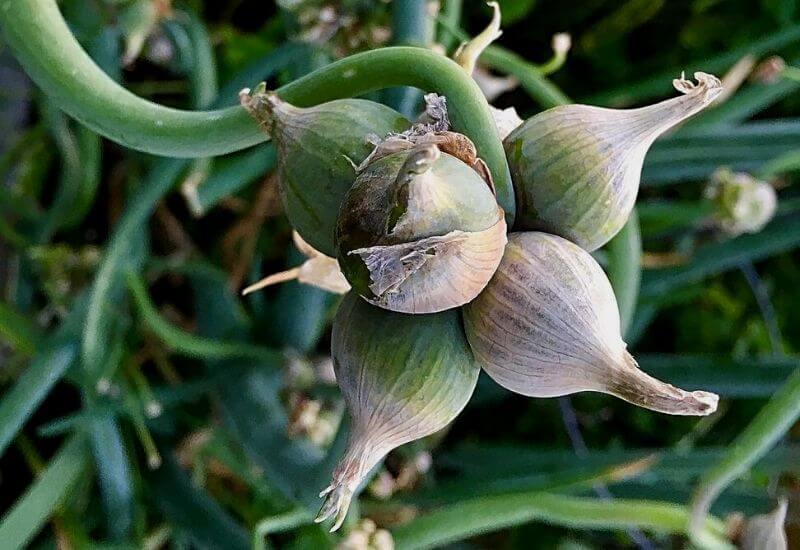
Sometimes called walking onions or bunching onions, this plant produces bulbs at the top of the plant rather than as a root vegetable, and then those bulbs can be planted or eaten. Many people say that Egyptian onions taste more like a shallot rather than an onion.
They’re called walking onions because the mature bulbs at the top of the plant become heavy, causing the plant to fall over. Then, the bulbs typically plant themselves where they land.
Sounds crazy, right? On average, Egyptian onions can “walk” up to two feet each year, so make sure to have the space cleared in your garden!
4. Garlic

Nearly everyone knows that you can grow garlic in the fall, but not everyone knows that you can keep it in the ground as a perennial plant.
You can leave the bulbs in the ground for several seasons, letting the garlic multiply on their own.
Rather than an entire head, you’ll end up with multiple small bulbs along with plenty of garlic scapes that you can use in the spring. Then, later, you can divide those bulbs and plant the individual cloves. It’ll give you a way to continue harvesting fresh garlic all year.
5. Globe Artichokes
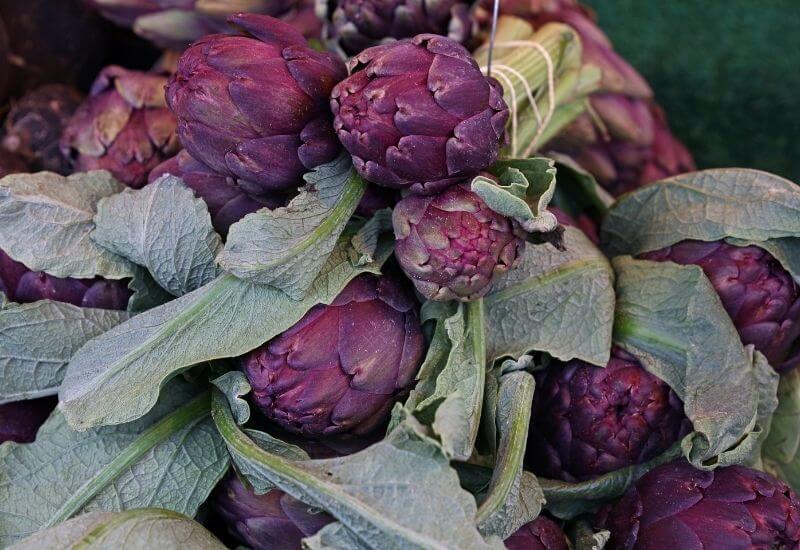
Artichokes aren’t as loved as they should be, but if you’re looking for a perennial vegetable, give globe artichokes a try.
This variety is a beautiful plant with a delicious flavor that is worth the wait considering its long growing season. It can take up to two years to reach your first harvest.
You can grow artichokes either as an annual or a perennial. If you want to grow these as annuals, you will need to protect them during the cold months. You do need to look for a variety that works best for your growing condition.
If you are a cold climate gardener, you can try growing artichokes in a greenhouse or high tunnel. Depending on the temperatures outside, some can grow artichokes as perennials successfully.
Typically, artichokes are only a perennial for USDA zones 7-10. If you happen to live in these climates, you can plant artichokes in a sunny garden bed with well-draining soil.
Make sure to amend the soil with plenty of compost before planting. They need to be top-dressed with compost each year.
6. Good King Henry
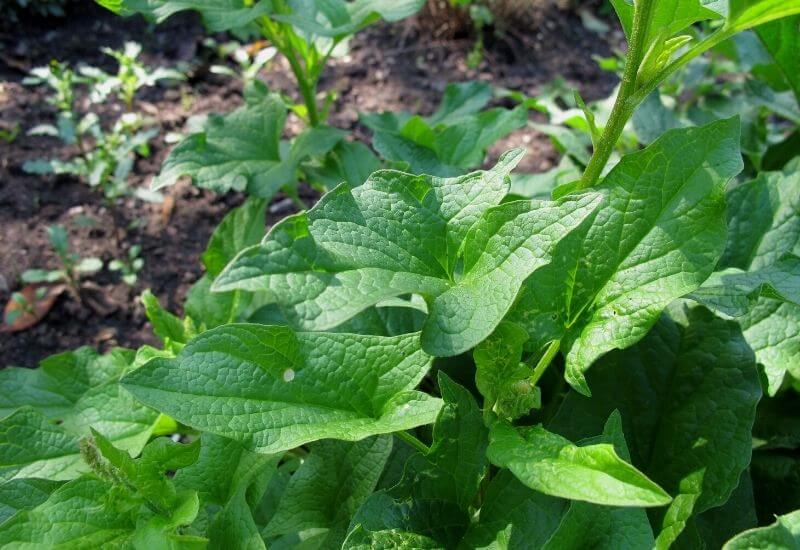
Chances are you’ve never heard of this vegetable, but it’s often called the poor man’s asparagus.
It can adapt to nearly anywhere, whether you have a nutrient-dense, beautiful garden or a basic garden bed without good soil.
This plant has a dual harvest. In the early spring, the plant sends up thick pencil shoots; you can harvest and use these like asparagus.
Then, harvest greens, which are the most beloved part of Good King Henry. The leaves can be eaten raw or steamed, but raw leaves have a bitter taste. Blanching or boiling takes away the bitter flavor.
Good King Henry grows well in both partial shade and full sunlight. You can either amend the soil or leave it the way it is. This plant doesn’t care either way.
You can harvest all of the plants’ parts, but all parts are high in oxalic acid, similar to sorrel and spinach.
It’s best to eat this vegetable in moderation. In general, it takes two to three years for these plants to offer a reasonable harvest.
7. Horseradish

If you need a bit of spice in your life, horseradish is something you can add to your meals or condiments to bring a bit of warmth to dishes.
You can do that by growing horseradish in your garden. This is a perennial root vegetable that you can harvest fresh throughout most of the year.
What you might not know, even if you love horseradish, is that it belongs to the Cruciferae family along with broccoli, cabbage, and Brussels sprouts. Unlike those vegetables, horseradish is hardy and withstand a wide fluctuation of temperatures.
8. Kale

Kale is typically grown as an annual; it’s hardy and has a short maturity time, making it a beloved plant to grow.
Most people add kale to their spring garden, and some grow kale in the fall garden, but you can grow kale in the winter even when the frost begins to appear.
Kale is technically a biennial, but it’s typically grown as an annual. It can be a perennial plant depending on your garden plans.
You can leave it in the garden over the winter, covering the plant with mulch, which lets the plant regrow in the early spring. In the spring, kale will send up new shoots.
9. Lovage

Here is an herb that was quite popular during the Middle Ages, but it’s been left in the dust for the last few centuries. That’s why it seems like a hidden secret today.
Lovage has a flavor similar to celery, but it’s much stronger, so you can use it any way you would use celery.
You don’t have to plant too much lovage; a few plants is sufficient for most families. These plants can reach up to seven feet tall, so plan to make many soups and stews this year.
If you don’t use all of it fresh, you can hang lovage to dry just like you would any other herb.
10. Oca
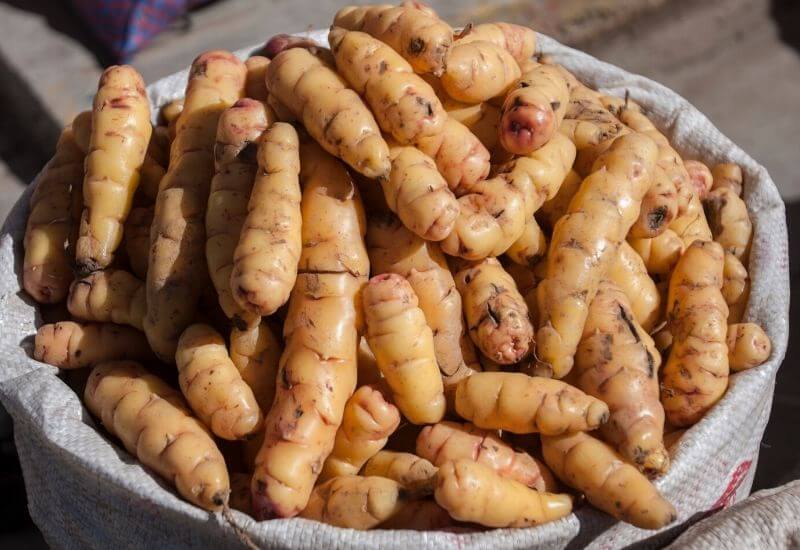
If you live in the north, you won’t be able to grow this veggie, but those who live in USDA zones 9-10 can try growing oca. This veggie is also called New Zealand yams.
Despite the name, it doesn’t originate from New Zealand; this vegetable is native to South America.
Oca produces waxy, colorful tubers that grow in the Andean region. These tubers need to be planted in the late winter indoors and planted outside when the danger of frost disappears.
It’s best to pick a spot that has well-draining soil and partial shade. If possible, find a place that has morning sunlight and afternoon shade.
Something else to know is that oca has a high moisture need, so they often need to be watered. You can plant the tubers in containers if you don’t want to use your garden beds, but use a potting mix for cactus. They come to harvest in the late fall.
11. Radicchio
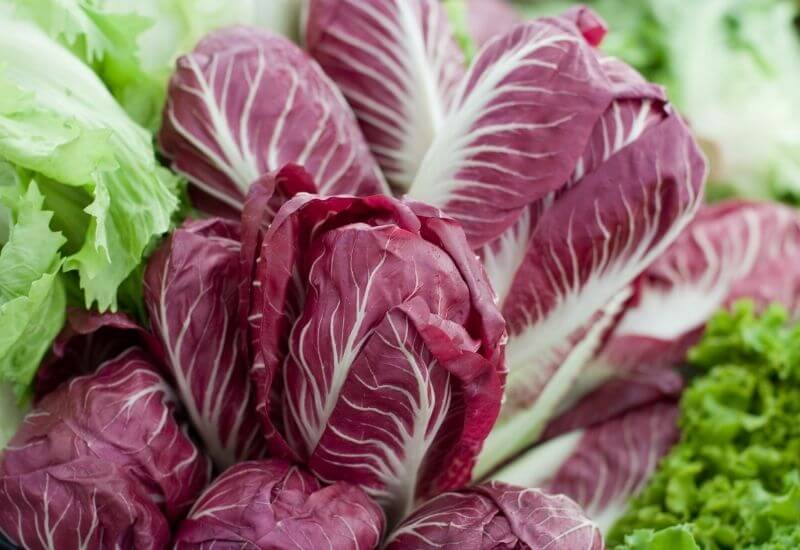
Most of the time, radicchio, typically called red chicory, is grown as an annual. It looks like a small red cabbage, and it’s commonly grown and eaten in Italy more than in the United States.
No one knows what radicchio is, and hardly anyone adds them to their garden in most other locations.
There are many reasons why radicchio is a vegetable that deserves recognition as one of the top perennial vegetables.
Not only is it frost tolerant, but it makes a healthy addition to your diet. Despite its bitter flavor, radicchio contains plenty of vitamins that your body needs.
You can harvest radicchio two times per year – in the spring and then again in the early fall.
12. Ramps
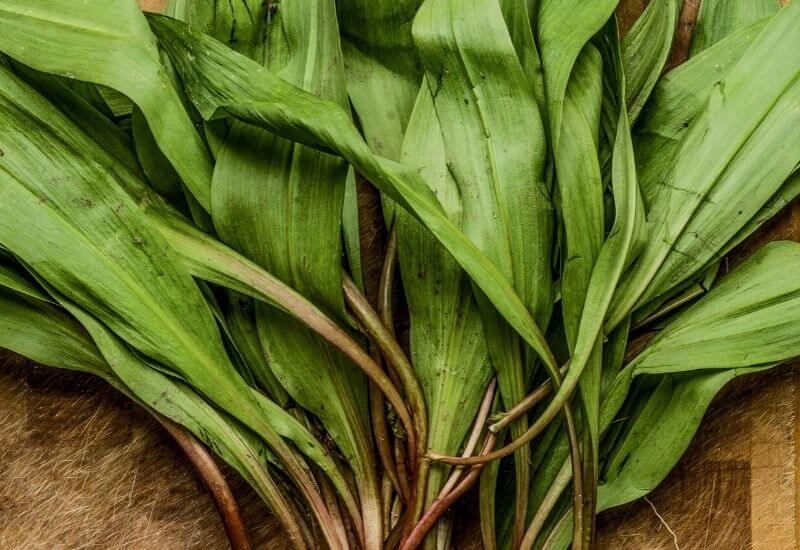
This vegetable goes by several names, such as ramsons, bear garlic, or wild leeks, but ramps are the most common name.
It’s a leafy green that you can forage and eat straight out of the forest in your backyard, or you can learn how to grow and cultivate ramps in your garden.
You can use all parts of the plant in dishes. The leaves, stems, and flowers are edible, so they make a great addition to your garden!
The only bad thing about growing ramps is that they can be hard to start from seeds. It’s best to plant bulbs; mulching is proven to help them grow well in the spring.
13. Rhubarb

One of the most popular perennial vegetables is rhubarb. A well-established rhubarb plant can last for up to 20 years; that’s a lot of vegetables!
Make sure you don’t eat the leaves because they’re poisonous; stick to the tart stalks instead.
You can’t harvest rhubarb in the first year; the roots need to establish before production begins. The plants will continue to get bigger as the seasons come and go.
14. Sorrel
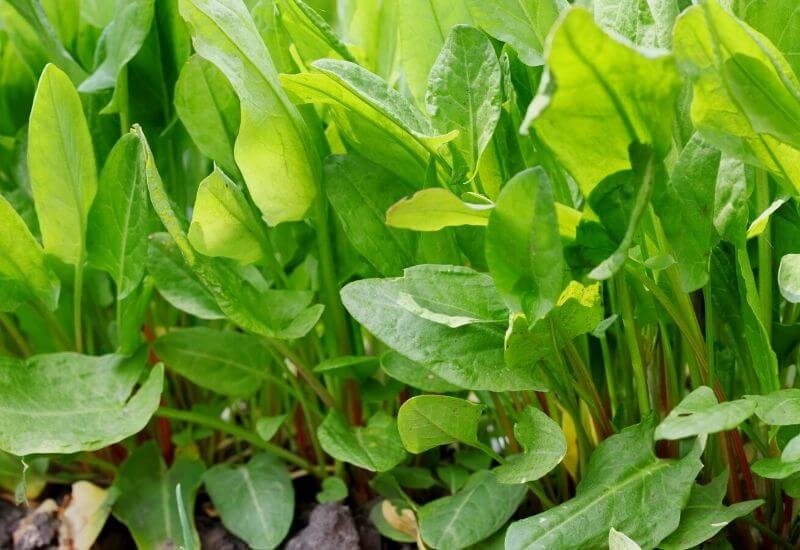
Here is one of the earliest greens that will emerge from the soil in the spring. Everyone who grows this says that it has a unique flavor, whether you want to call it tangy, lemony, or zingy.
It takes some time to adjust to the taste, but it has tons of nutrients that you need when winter ends.
Sorrel forms in large clumps of green leaves, needing either full sunlight or partial shade to thrive.
Before you plant, make sure you add a few inches of compost. You can grow sorrel from seeds indoors or grab a plant from your local nursery, if available.
Another option is to take a division from an existing sorrel plant if you can find one. It’s best to divide the plant in early summer, which gives it enough time to settle and establish before the cold weather arrives.
You can expect sorrel to produce well until June or July, depending on the outside temperatures, and then it will start to flower.
Always pick the leaves when they’re young and tender; they have the best flavor.
Make sure you clip the flowers as they fade because, if they drop to the ground, the plant will self-seed and invade your entire garden bed.
15. Sunchokes
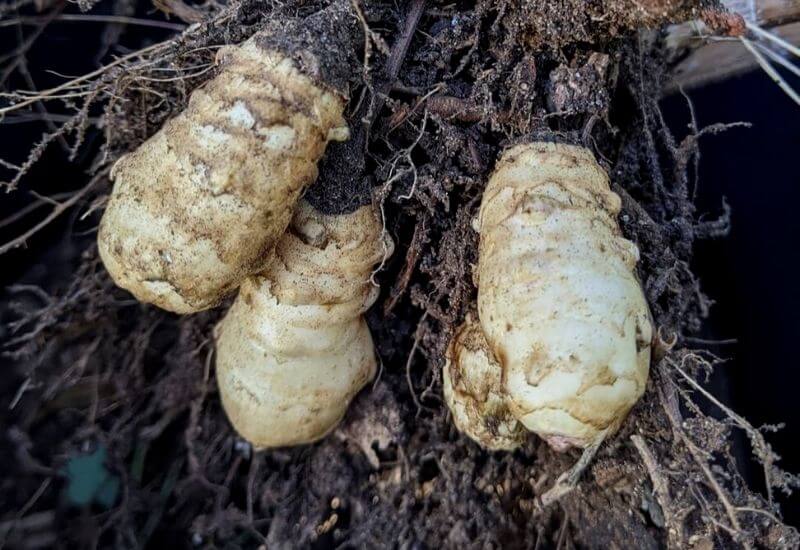
Sometimes called Jerusalem artichokes, sunchokes are another native North American plant that grows knobby tubers in the fall.
You can harvest sunchokes into the winter if you mulch the garden bed with straw or shredded leaves. Another option is to harvest the tubers in the fall and store them in your cold root cellar.
Sunchokes truly accomplish the ornamental factor; these plants are tall with sunflower-like flowers that bloom in the late summer. These blooms attract all kinds of pollinators to your garden.
Jerusalem artichokes come in several varieties, so you might want to select a few different ones to grow because they have different colors and tuber shapes.
Planting these veggies is easy. You need a garden bed with full sunlight and well-draining soil; plant sunchokes in mid-spring.
It’s best to pick a spot isolated or bordered away from other plants because these plants spread vigorously. Plant the tubers four to five inches deep and 18 inches apart.
16. Three-Cornered Leek
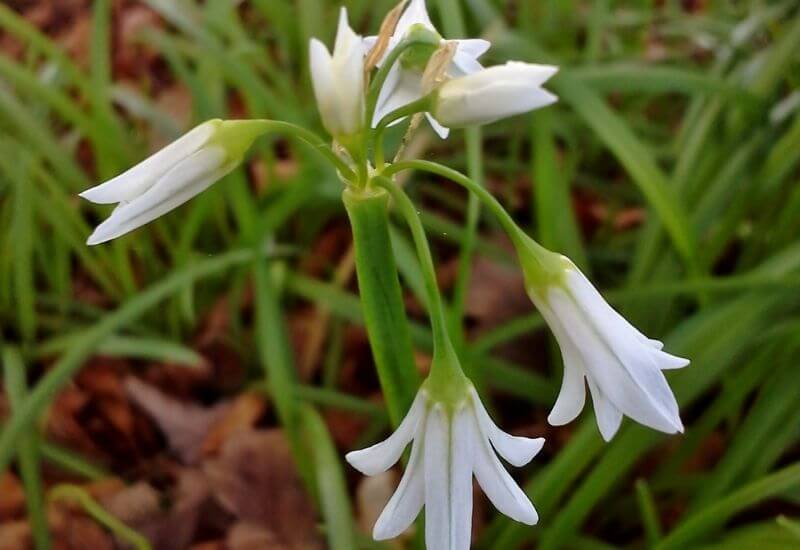
Chances are you’ve never heard of three-cornered leeks because they’re an exotic, native plant that originates in the Mediterranean region. They’re a plant that foragers love.
If you’re lucky enough to get your hands on a few bulbs, you can transplant them in your garden, so you’ll be able to harvest them quickly in April and May when the plants start to flower. You can harvest the leaves in the late fall when the leeks begin to fade.
17. Watercress
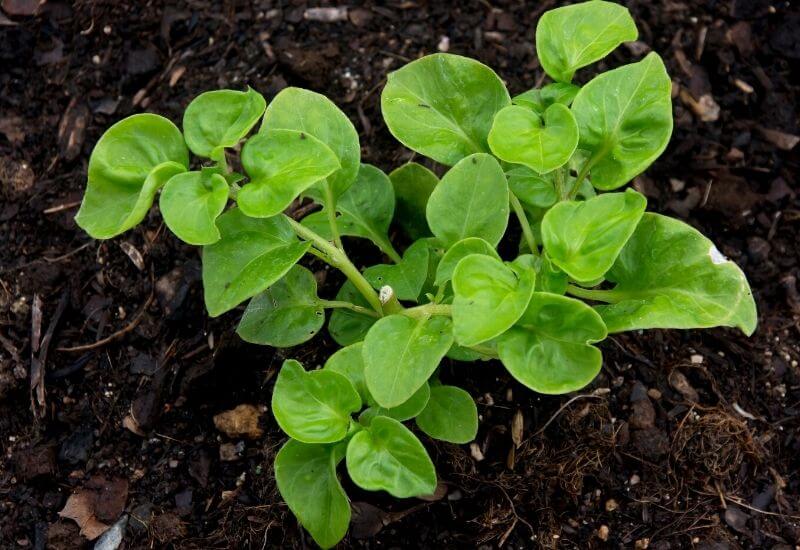
Have you never heard of watercress before? You aren’t alone! Even experienced gardeners have never tried to grow watercress, but it’s making a slow comeback as people explore new, unique greens for salads.
Watercress has a peppery taste, similar to arugula. If you’re looking for a green that you can add to your garden for pops of flavor, watercress is a great option.
The only negative to growing watercress is that it can be a bit hard to grow. Pests love this green, including snails, whiteflies, and spider mites. It’s worth the trouble, though, because it can grow nearly year-round in most zones, providing you with rich nutrients throughout the year.
Try Growing Perennial Vegetables
If you want to grow more food without more work, adding perennial vegetables is the answer to your problem. You plant these one time, and then each year, you harvest more and more from them without doing more work on your end.

Written By
Amber Noyes
Amber Noyes was born and raised in a suburban California town, San Mateo. She holds a master’s degree in horticulture from the University of California as well as a BS in Biology from the University of San Francisco. With experience working on an organic farm, water conservation research, farmers’ markets, and plant nursery, she understands what makes plants thrive and how we can better understand the connection between microclimate and plant health. When she’s not on the land, Amber loves informing people of new ideas/things related to gardening, especially organic gardening, houseplants, and growing plants in a small space.
